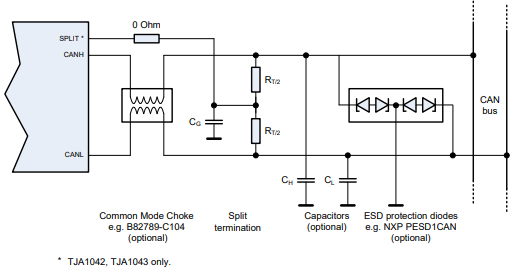1)I am trying to the understand the important parameters of a common mode choke that will be placed at the CANL and CANH lines of a transceiver.First parameter - Impedance as function of frequency - I'm looking up the impedance value at 500kHz in the graph, since my application data rate is 500kbps. Is this right ? Second parameter - Insulating resistance -How important is the insulating resistance between windings, in my understanding the more the insulating resistance is the more better the common mode choke is, is my understanding right? Also how important is stray inductance ? there is one other parameter called DC resistance(each line) given as a percentage ,could someone please explain what parameter this is ?

2)This question is regarding the CAN lines termination - in split termination technique ,there is a capacitor between the resistors connected to ground. In a lot of application notes that I've read, the value is always 4.7nF for the capacitor, I'm trying to understand how this value is chosen. "EMC measurements have shown that the Split Termination is able to improve significantly the signal symmetry between CANH and CANL, thus reducing emission. Basically each of the two termination resistors is split into two resistors of equal value, i.e. two resistors of 60ohm (or 62ohm) instead of one resistor of 120ohm. The special characteristic of this approach is that the common mode signal, available at the centre tap of the termination, is terminated to ground via a capacitor. The recommended value for this capacitor is in the range of 4,7nF to 47nF" - this is from the application note AH1014 Application Hints - Standalone high speed CAN transceiver TJA1042 / TJA1043 / TJA1048 / TJA1051 How is this capacitor value quantified ? Would it be okay to use 100nF instead of 4.7nF ? I read a few more TI documents where they have calculated the corner frequency of the RC filter - 1/2*piRC , and R is taken as 30ohm, so the corner frequency for 4.7nF is 1.1Mhz. Does this mean all the noise above 1.1Mhz is cutoff , so therefore if the capacitor value is increased the cutoff frequency decreases , for 100nF - the cutoff frequency is around 50kHz. Should the data rate of CAN be considered ?the data rate is 500kbps, should the capacitor value be so selected that the cutoff frequency is above the data rate at all times ?

2)This question is regarding the CAN lines termination - in split termination technique ,there is a capacitor between the resistors connected to ground. In a lot of application notes that I've read, the value is always 4.7nF for the capacitor, I'm trying to understand how this value is chosen. "EMC measurements have shown that the Split Termination is able to improve significantly the signal symmetry between CANH and CANL, thus reducing emission. Basically each of the two termination resistors is split into two resistors of equal value, i.e. two resistors of 60ohm (or 62ohm) instead of one resistor of 120ohm. The special characteristic of this approach is that the common mode signal, available at the centre tap of the termination, is terminated to ground via a capacitor. The recommended value for this capacitor is in the range of 4,7nF to 47nF" - this is from the application note AH1014 Application Hints - Standalone high speed CAN transceiver TJA1042 / TJA1043 / TJA1048 / TJA1051 How is this capacitor value quantified ? Would it be okay to use 100nF instead of 4.7nF ? I read a few more TI documents where they have calculated the corner frequency of the RC filter - 1/2*piRC , and R is taken as 30ohm, so the corner frequency for 4.7nF is 1.1Mhz. Does this mean all the noise above 1.1Mhz is cutoff , so therefore if the capacitor value is increased the cutoff frequency decreases , for 100nF - the cutoff frequency is around 50kHz. Should the data rate of CAN be considered ?the data rate is 500kbps, should the capacitor value be so selected that the cutoff frequency is above the data rate at all times ?
